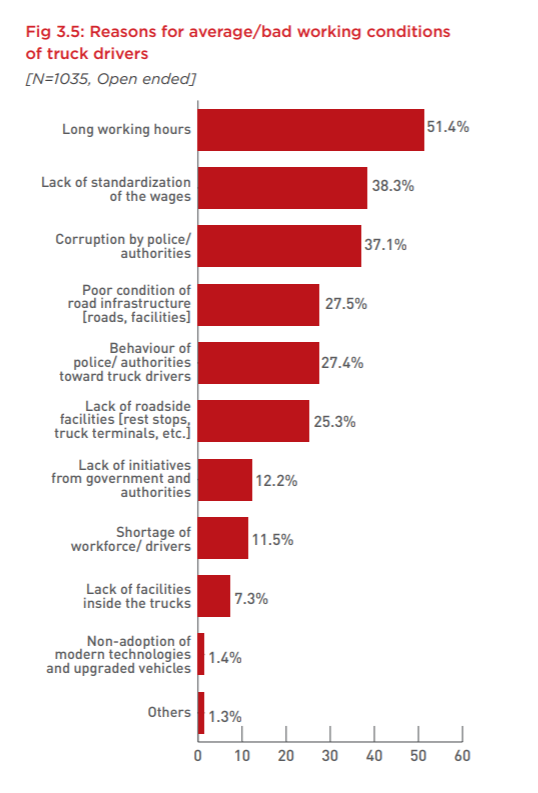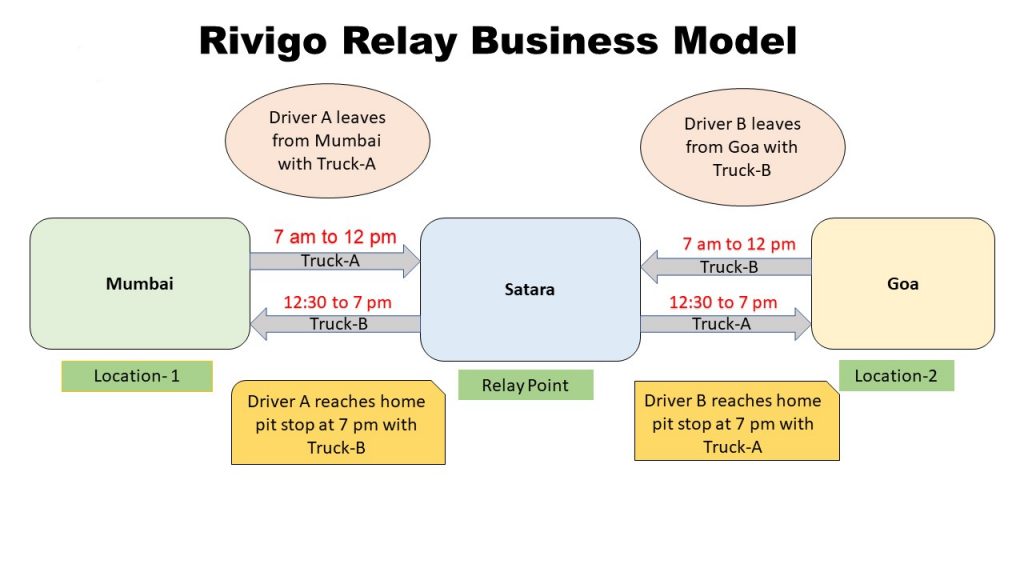Right from my childhood, I always used to wonder about truck drivers and their family life. Particularly when I used to travel by bus or car to my native place, especially at night. Along with my bus, there used to be a flurry of trucks alongside, moving some goods from one place to another.
I used to think what makes it is so urgent that these truck drivers are working day and night! Until Covid came, and we finally realized the importance of Supply chains. Along with frontline warriors like doctors, police force, hospital, and support staff; truck drivers are unsung heroes in this pandemic.
Everything stopped; offices, malls, restaurants, entertainment centers; however, the supply of essential goods continued even so. But, even after this selfless service, do the truck drivers get the deserved respect from society?
The answer is ‘NO.’ Not even a single kid aspires to be a truck driver in his childhood. Moreover, truck drivers themselves do not want their kids to become truck drivers. As per a survey by Save Life Foundation, 84% of truck drivers respondents would not recommend the profession to a family member. Because of this, the supply of truck drivers is reducing day by day.
The key issue is drivers spending months away from their families. Moreover, parents are unwilling to marry their daughters off to truck drivers. They (truck drivers) are almost an outcast.

Realizing these real issues, Deepak Garg, McKinsey alumnus, came up with the company Rivigo. It is based on the Relay Trucking model. This unique solution solves the truck driver’s shortage while helping drivers maintain a healthy work-life balance by allowing them to be at their home every day. The model also helps shorten the delivery time and increase truck efficiency. Let’s try to understand the Business Model of Rivigo.
Concept of Rivigo Relay Business Model:
In this business model of Rivigo, the truck drivers work in shifts, handing over the truck to the next driver at designated pit stops along the route. Having handed over the truck, the driver then takes the wheel of another truck to make the return journey so that he is back at his home stop by the end of the day.
This process also increases trucking efficiency by higher utilization of trucks. Rivigo has created a network of over 70 pit stops over the country. This approximately translates to a driving distance of around 250 km or around 5 hrs of driving time between pitstops.
The truck driver gets a duty alert on his phone. He reaches the pitstop and scans the unique QR code. The incoming truck driver has already got an alert on his app as to which truck driver the truck is to be hand over to. In addition to tech exchange through QR codes, there is a checklist regarding trucks and shipments’ conditions that need to be verified through the app.

The Business model of Rivigo is based on the best use of technology. Rivigo also has IoT-enabled trucks with conditions of trucks being monitored in real-time. This monitoring not only helps in reducing breakdowns but also in increasing the trust of clients.
Moreover, if a refrigerated truck takes fresh fruits or fish, the client can see that the temperature is maintained. This transparency is high-value addition amongst the clients of supply chain logistics.
We offer a unique and industry-first proposition for temperature integrity and quality management by having a remote temperature management system for our fleet. This technology eliminates the dependency on drivers for temperature control during transit
Rivigo website
RaaS: Relay-As-A-Service of Rivigo
The co-founder of Rivigo, Gazal Kalra, told YourStory in an interview that RaaS aims to offer the benefits of relay trucking to millions of fleet owners in India while bringing efficiencies in the logistics industry. The mission of Rivigo is to make logistics in India more humane, efficient and RaaS is one step in that direction.
Surge cargo logistics, a client of Rivigo, shares that 25-30 percent extra running per month per truck was achieved through RaaS, compared to using their own resources. The use of tech in all aspects of operations (fuel, maintenance) is also helping the client see the areas of concern in their trucks.
Patent and Funding
Rivigo, in July 2019 had announced that it had been granted patent rights by the United States Patent and Trademark Office for its unique driver relay model that uses algorithms to determine the availability of drivers for trucks.
The patented system of Rivigo uses the technology of an intelligent driver allocation system to pick the right driver for duty. The selection is based on many parameters like an equal distribution of driving hours, rest hours, and transit hours. The algorithm also considers driver performance basis on parameters like driving behavior, fuel usage, etc.
According to the Ministry of Corporate Affairs, Rivigo raised a Series F funding round of INR 141.97 Cr ($20 Mn) from SAIF Partners and Spring Canter Investment Ltd in late 2019. Out of this, INR 141.97 Cr, Spring Canter invested 83.18 Cr while SAIF Partners invested 58.7 Cr. Rivigo said in its filings that it plans to use the funding towards capital expenditure.
In 2019, Rivigo also launched the National Freight Index (NFI) to bring transparency to the largely unorganized logistics sector. It provides fleet owners and logistics decision-makers unrestricted access to freight rate information and trends.
Challenges Rivigo Business Model Can Face with Autonomous vehicles
Fully automated trucks are commercially viable only if they improve both cost and safety considerably. However, the biggest challenge for fully automated trucks is the availability of data and training capabilities.
It is a herculean task to replace a human driver for all possible weather conditions and road conditions. A more amazing thing would be to see how autonomous trucks interact with humans and other non-autonomous trucks. This culminates in predicting every single thing around the truck with extremely high accuracy.
This then translates to the need for data of trillions of real driven miles. Also, with the unimaginable amount of data, the cost of servers makes it all more difficult to put fully autonomous vehicles in practice.
Conclusion
Rivigo aims to scale by offering Relay as a Service (RaaS) to fleet owners, who find it difficult to get truck drivers and make their trucks efficient. In the next five years, Rivigo aims to run 30,000 to 50,000 trucks in the relay ecosystem. It also aims to put the next technology on IoT sensors and manage the fleet of fleet owners. The founder, Deepak Garg envisions changing the lives of more than 1,00,000 truck drivers by the year 2024.
-AMAZONPOLLY-ONLYWORDS-START-
Also, check out our most loved stories below

Why did Michelin, a tire company, decide to rate restaurants?
Is ‘Michelin Star’ by the same Michelin that sells tires, yes, it is! But Why? How a tire company evaluations became most coveted in the culinary industry?

Bajaj Auto: The Story of an Indian Born Global Brand
Bajaj Auto has evolved tremendously over time from its traditional scooter Chetak to having the trendiest bike Pulsar. It has managed to stay relevant.

Jio’s Offensive Marketing Warfare: From Challenger to Leader
In just 4 years Reliance Jio has become the Indian telecom market leader due to its marketing warfare strategies. What is this strategy and how Jio used it?

Johnnie Walker – The legend that keeps walking!
Johnnie Walker is a 200 years old brand but it is still going strong with its marketing strategies and bold attitude to challenge the conventional norms.

Flipsters: Creating the Butterfly effect in Indian Startup Ecosystem
How is it that ex-Flipkart employees or Flipsters as they call themselves have achieved such massive success in the Indian Startup Ecosystem?

Nike doesn’t sell shoes. It sells an idea!!
Nike has built one of the most powerful brands in the world through its benefit based marketing strategy. What is this strategy and how Nike has used it?

Domino’s is not a pizza delivery company. What is it then?
How one step towards digital transformation completely changed the brand perception of Domino’s from a pizza delivery company to a technology company?

Why Indians love Old Monk? What is the revival plan of the dying brand?
Indians especially armed forces and college students for generations have loved Old Monk. What makes this rum so special? It’s classy, dark yet affordable.

IKEA- The new master of Glocalization in India?
IKEA is a global giant. But for India, the brand modified its business strategies. The adaptation strategy by a global brand is called Glocalization
-AMAZONPOLLY-ONLYWORDS-END-

















1 Comment
It is a superb model when and where it works, however scaling this can sometimes be a very difficult and sequential process due to the following reasons –
1) India’s consumption hubs and production centres are unevenly balanced making goods movement very one-sided which is the biggest challenge to maintaining balance of goods to make the model feasible and profitable (reduce empty miles). This becomes more so as you try entering smaller cities which make bulk of india movement.
2) Truck types (body length, height, tonnage, platform, dala specification, etc) vary greatly in India for different materials. There are over 400-500 different truck types on the road, many of which become highly sub-optimal (and hence costly) for different goods movement esp. when you need to balance consistent 2/3 way return.
3) Document, cash, truck maintenance management etc. becomes an altogether different business in itself as fleet size increases and needs dedicated teams to manage the scale and transactions.
4) With own fleet and tech. comes increased cost and asset depreciation which Indian industries are not ready to accept (esp. since enough fleet owners and drivers still compete) as they are already invested in Warehouse partnerships and unwilling/unable to move away to a low inventory model that Rivigo can help introduce.
5) Drivers and stakeholders need/may have been promised more than market returns basis model’s expected benefits and when that doesn’t materialise due to above issues, stakeholders start feeling unequal and bring other people issues into picture.
6) Most of Rivigo’s initial fleet is over 5 years old now (when truck inefficiencies and maintenance requirements start building up big time)
Most of these are due to logistics industry still being looked at and working as a very legacy industry and a cost function for producers and stakeholders. But this will need a lot of time and investments to get all the potential benefits kicking in and get other stakeholders’ buy-in.